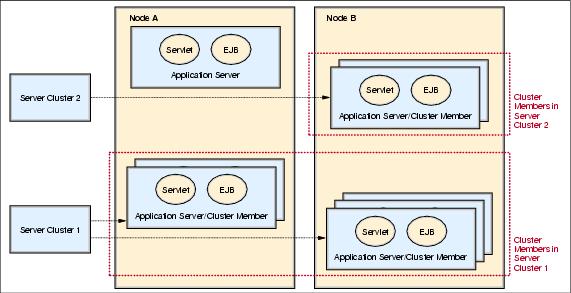Workload management using WebSphere clustering
This section describes how workload management is implemented in IBM WAS Network Deployment V5.1 by using application clusters.
A cluster is a set of appservers that are managed together and participate in workload management. Application servers participating in a cluster can be on the same node or on different nodes. A Network Deployment cell can contain no clusters, or have many clusters depending on the need of the administration of the cell.
The cluster is a logical representation of the appservers. It is not necessarily associated with any node, and does not correspond to any real server process running on any node. A cluster contains only application servers, and the weighted workload capacity associated with those servers.
When creating a cluster, it is possible to select an existing appserver as the template for the cluster without adding that application server into the new cluster. This allows for continued development in the existing application, for example while using the definition for the cluster.
Cluster members can be added to a cluster in various ways - during cluster creation and afterwards. During cluster creation, one existing appserver can be added to the cluster and/or one or more new application servers can be created and added to the cluster. There is also the possibility to add additional members to an existing cluster.
Cluster members are required to have identical application components, but can be sized differently in terms of weight, heap size, and other environmental factors. This allows large enterprise machines to belong to a cluster that also contains smaller machines such as Intel® based Windows® servers.
Starting or stopping the cluster will automatically start or stop all the cluster members, and changes to the application will be propagated to all appservers in the cluster.
Figure 1-5 shows an example of a possible configuration that includes server clusters. Server cluster 1 has two cluster members on node A and three cluster members on node B. Server cluster 2, which is completely independent of server cluster 1, has two cluster members on node B only. Finally, node A also contains a free-standing appserver that is not a member of any cluster.

Figure 1-5 Server clusters and cluster members
Clusters and cluster members provide necessary support for workload management, failover, and scalability.
WebSphere is a trademark of the IBM Corporation in the United States, other countries, or both.
IBM is a trademark of the IBM Corporation in the United States, other countries, or both.